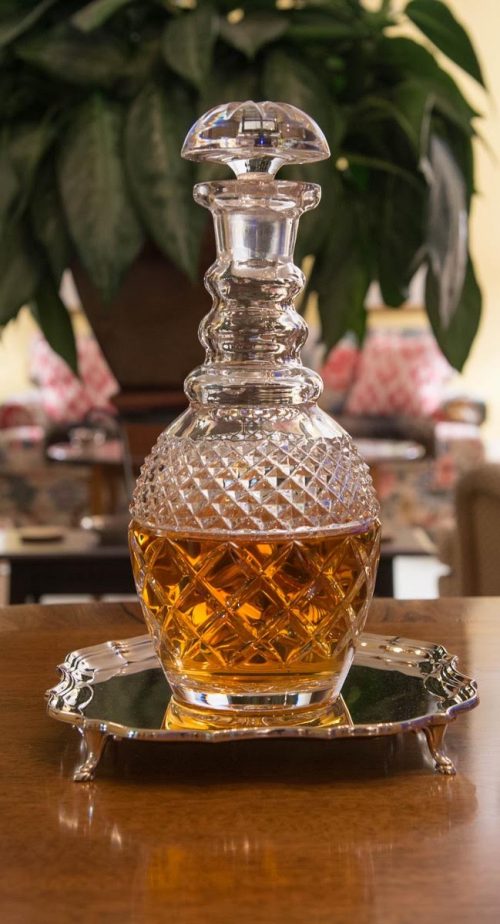By Ed Schimmelpfennig
The holiday season heralds a time for serious merrymaking – with a growing number of revelers enjoying our country’s native elixir, AMERICAN BOURBON WHISKEY. Originally produced as a cooking mainstay and “for medicinal purposes” (who hasn’t used the expression when hoisting that second or possibly third drink?), bourbon today provides comfort to enthusiasts around the world … many of whom might not recognize its rich history. These devotees might agree, however, that a well-run household maintains adequate stocking, proper safekeeping, and a respectful appreciation of this amber treasure — which is why, at the center of my dining room table for over forty years, a Heaven Hill Bourbon has been importantly displayed in a cherished Spaulding & Co. decanter. (The brand’s 18-year-old single barrel bourbon is touted as the oldest in the world.)
Certainly the origin and development of bourbon make for lively conversation. From the very beginning, corn was Kentucky’s most abundant field crop, though the market value was not strong enough to support its many producers. As a corn-produced distillate, that balance would change. As John Kleber points out in THE KENTUCKY ENCYCLOPEDIA, one mule could haul only four bushels of corn, but as a distillate, a single mule could carry nearly SIX times that amount.
Upon discovering this equation, hundreds of farmers – many from Scotland and Ireland — began making whiskey throughout Kentucky – utilizing iron-free water that had been naturally-produced and filtered through concentrated limestone. By 1789, Elijah Craig, a Baptist minister, entrepreneur, and educator refined the formula further. By aging the clear, local corn distillate in charred oak barrels, he created the familiar red-brown color and distinctive taste that we know so well today. Little could he guess that years later, such barrels would be sold off and used to influence the flavorful taste of Scotch whiskies and Spanish sherries. (Even Chicago’s micro-brewer Goose Island is said to use such barrels to produce its Bourbon County Imperial Stout.)
By 1810, there were reportedly 2,200 operational distilleries. Brand names established then are still recognizable today: James E. Pepper of Lexington produced “Old Pepper Whiskey,” Evan Williams of Louisville introduced his namesake formula (rumored to be the oldest bourbon in Kentucky – a fine product and exceptional value – where the same 200-year-old recipe is still being employed), and “Old Crow,” created by Dr. James Crowe, an Englishman in Woodford County.
Early whiskies still in production would also include “Blanton’s Single-Barrel Bourbon,” never blended with other-age whiskies, and “Wild Turkey”, so named when the head of the Austin Nichols Company, a grocery concern, brought along his private stock on “preservationist” turkey shoots. The only real “shots” were those of bourbon. Another favorite, Very Old Barton, produced in Bardstown by Barton’s Distillery, began operation in the early 1800’s. Maker’s Mark, distilled by the Samuels Family for seven generations in Loretta, Kentucky, has traditionally used winter wheat to flavor its recipe. The early list goes on and on: Four Roses, Jim Beam (founded in 1795), W.L. Weller which was first bottled in 1849 using corn, malted barley and wheat.
In recent times, there has been a monumental production of bourbon. In 2015, Kentucky distilleries filled over 1,886,820 barrels of the golden nectar – allowing the Commonwealth to boast that a total inventory of over 6,657,063 barrels of bourbon “were gently aging in Bluegrass warehouses.”
On a slightly smaller scale, Chicagoland has added its own collection of bourbon distillers– most of which offer individual tours: Chicago Distilling Company / Blind Tiger Bourbon / Chicago; Few Bourbon / Evanston; Koval Bourbon / Ravenswood; Soltis Family Bourbon, suburban Thornton. For those traveling to nearby Michigan, there is also Journeyman Distillery in Three Oaks, offering its signature Featherstone Bourbon.
Apart from being served “neat”(at room temperature, without water, mixer, or ice) or “up” (chilled and served without ice), Bourbon becomes the penultimate component of the traditional cocktail. Who doesn’t have a favorite? Among the most popular are those known by very particular names: The Manhattan, Old-Fashioned, Mint Julep (at Derby Time or during the Keeneland Stakes), Whiskey Sour, Highball, and Sazarac.
Finally, let’s identify several of the best guides for constructing that perfect drink. Possibly the oldest, and surely best remembered by many, is “The Old Mr. Boston Official Bartender’s Guide” – first introduced in 1935 and reprinted many times since. It is a gem. Another personal favorite is “How’s Your Drink?” – “one of the most entertaining books ever written on the culture of the American cocktail,” created by WSJ freelance columnist, Eric Felten. I would use the word FASCINATING to describe this little tome. In addition, Alfred Tong’s “The Gentleman’s Guide to Cocktails” outlines not only the ingredients of a favorite cocktail but also how to order it properly without facing social oblivion. (A leather-bound version can be found this holiday at Paul Stuart for $115 where enthusiasts are also being offered a curious little book entitled, “Tequila Mockingbird … Cocktails with a Literary Twist.” (On second thought, it might not be right for a bourbon drinker.) I could find other great bartending books on my shelf, but this list gets you started.
As you get ready for the holidays, simply remember that a bourbon is to be savored like a wine – with an eye for color, bouquet, flavor, and finish. Simply add gusto … and the best glasses you own!
Photo Credit: Ted Glasoe












